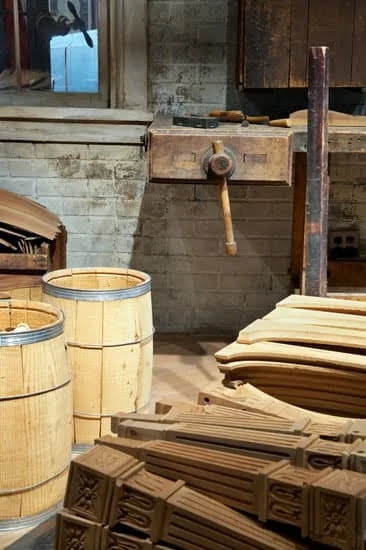What does bleach do to acrylic paint on woodwork? Bleach is a commonly used household cleaning agent known for its powerful disinfecting properties. However, its effects on acrylic paint, particularly when applied to woodwork, are not as well known. Acrylic paint, on the other hand, is a popular choice for adding color and protection to wooden surfaces due to its versatility and durability.
In this article, we will explore the interaction between bleach and acrylic paint on woodwork, detailing the chemical reactions that occur and the resulting effects on the paint’s color, texture, and finish. Additionally, we will discuss potential risks and hazards associated with using bleach on acrylic paint, as well as provide guidance on how to safely remove or repair bleached acrylic paint.
We will also explore alternative methods for paint removal and offer tips for protecting and maintaining the quality of acrylic paint on woodwork.
Understanding how bleach interacts with acrylic paint on woodwork is crucial for maintaining the integrity of painted surfaces. Whether you are looking to remove unwanted paint or protect existing acrylic finishes from damage, this comprehensive guide aims to provide valuable insights and practical advice for homeowners and DIY enthusiasts alike. So let’s delve into the fascinating world of bleach and acrylic paint on woodwork to uncover their unique relationship and implications.
Effects of Bleach on Acrylic Paint
Bleach is a powerful chemical that is commonly used for disinfecting, cleaning, and whitening various surfaces. When it comes into contact with acrylic paint on woodwork, the effects can be significant. Acrylic paint is known for its vibrant colors and durable finish when applied to wood surfaces. However, when bleach comes into play, the reaction between the two can cause notable changes in the appearance and texture of the paint.
One of the primary effects of bleach on acrylic paint is that it can cause discoloration. The chemical reaction between bleach and the pigments in acrylic paint can lead to fading or lightening of the colors. This can result in a splotchy or uneven appearance, which significantly alters the original aesthetic of the painted woodwork.
Additionally, bleach can also affect the texture of acrylic paint, causing it to become brittle or crack over time. This compromises the integrity of the paint and diminishes its overall visual appeal.
The finish of acrylic paint on woodwork may also be compromised by bleach. Depending on the concentration and duration of exposure to bleach, it can cause a dulling or loss of sheen in the paint’s finish. This means that areas treated with bleach may appear noticeably different from unaffected areas, resulting in an uneven or patchy appearance. It’s essential to understand these potential effects before using bleach on acrylic paint to avoid unintended damage to your woodwork.
- Effects of Bleach on Acrylic Paint:
- Discoloration
- Texture changes
- Compromised finish
Potential Risks and Hazards
The use of bleach on acrylic paint can have several potential risks and hazards that individuals should be aware of before attempting to use this chemical for paint removal or cleaning purposes. Bleach is a highly corrosive substance that can cause damage to the skin, eyes, and respiratory system if proper precautions are not taken. When used on acrylic paint, bleach can result in color fading, texture alteration, and even complete removal of the paint from woodwork.
One of the main risks associated with using bleach on acrylic paint is the chemical reaction between the two substances. Bleach contains chlorine, which can break down the pigments and binders present in acrylic paint. This can lead to discoloration of the paint and a change in its overall appearance. In addition, bleach may also affect the texture of acrylic paint, causing it to become brittle or flake off from the woodwork.
In terms of safety precautions, it is crucial to handle bleach with care and use protective gear such as gloves, goggles, and a mask when working with this chemical. Proper ventilation is also essential to prevent inhalation of toxic fumes. Furthermore, individuals should avoid mixing bleach with other cleaning products or chemicals as this can create potentially harmful reactions. It’s important to remember that improper handling of bleach can result in serious health consequences.
| Risks | Hazards |
|---|---|
| Discoloration of acrylic paint | Skin and eye damage from contact with bleach |
| Texture alteration of paint | Respiratory issues from inhaling toxic fumes |
| Bleaching or removal of the paint from woodwork | Chemical reactions from mixtures with other products |
Removing Acrylic Paint With Bleach
When it comes to removing acrylic paint from woodwork, bleach can be a powerful tool. However, it’s important to understand the potential effects and limitations of using bleach in this context.
When bleach comes into contact with acrylic paint on woodwork, it can break down the pigments in the paint, causing discoloration and damage to the finish. The chemical reaction between bleach and acrylic paint can result in a faded or whitened appearance, altering the color and texture of the paint.
The effectiveness of using bleach to remove acrylic paint from woodwork depends on several factors, including the type of acrylic paint used, the length of time the paint has been on the surface, and the concentration of bleach being applied. It’s important to note that while bleach can effectively remove some types of acrylic paint from woodwork, it may not work as well on others.
Additionally, using too much bleach or leaving it on for too long can lead to further damage to the wood itself.
One alternative method for removing acrylic paint from woodwork is using a commercial paint remover specifically designed for use on wooden surfaces. These products are formulated to break down the bonds in acrylic paint without causing damage to the underlying wood.
Another option is using sandpaper or a heat gun to strip away layers of acrylic paint. Each method has its own advantages and limitations, so it’s crucial to carefully consider which approach is best suited for your specific project.
| Effects of Using Bleach | Alternative Methods |
|---|---|
| The chemical reaction with bleach causes discoloration and damage to finish | Commercial paint remover designed for wooden surfaces |
| Bleach may not effectively remove all types of acrylic paints | Sandpaper or heat gun as alternatives |
Alternative Methods for Paint Removal
When it comes to removing acrylic paint from woodwork, bleach is not the only option available. There are several alternative methods that can be used to effectively remove paint without causing damage to the underlying wood. Each method has its pros and cons, so it’s important to consider which approach is best suited for the specific project at hand.
Sanding
One of the most common methods for removing acrylic paint from woodwork is sanding. This process involves using sandpaper or a power sander to physically remove the paint from the surface of the wood. While effective, sanding can be time-consuming and labor-intensive, especially for large or intricate surfaces. Additionally, sanding can create a significant amount of dust and debris, so proper safety precautions should be taken.
Heat Stripping
Another popular method for paint removal is heat stripping. This technique involves using a heat gun or specialized infrared heaters to soften and loosen the paint, making it easier to scrape away. While heat stripping can be effective, it also requires caution as excessive heat can damage the wood and pose fire hazards if not used properly.
Chemical Paint Strippers
Chemical paint strippers are another alternative for removing acrylic paint from woodwork. These products work by breaking down the molecular bonds of the paint, allowing it to be easily scraped away. However, it’s important to follow all safety guidelines when using chemical strippers, as they can be toxic and pose health risks if not handled properly.
In considering these alternative methods for paint removal, it’s important to weigh the effectiveness of each approach against potential risks and limitations. Factors such as the size of the project, type of wood surface, and personal safety considerations should all be taken into account when deciding on an appropriate method for removing acrylic paint from woodwork.
Protecting Acrylic Paint From Bleach
Preventative Measures and Sealants
When it comes to protecting acrylic paint from bleach, prevention is key. One of the most effective ways to safeguard acrylic paint on woodwork is by applying a high-quality sealant. Sealants create a protective barrier that helps repel liquids, including bleach, from penetrating the paint and causing damage. Look for sealants specifically designed for use on acrylic paint and follow the manufacturer’s instructions for proper application.
In addition to sealants, taking preventative measures can also help protect acrylic paint from bleach. Avoid exposing painted woodwork to bleach or other harsh chemicals whenever possible. Use caution when handling cleaning products in the vicinity of acrylic-painted surfaces, and immediately wipe away any spills or splatters before they have a chance to cause damage.
Tips for Maintenance
Proper maintenance is essential for preserving the longevity and quality of acrylic paint on woodwork. Regularly inspect painted surfaces for signs of wear or damage, and address any issues promptly. Clean the surfaces gently with a mild soap and water solution, being careful not to scrub too vigorously or use abrasive cleaners that could compromise the integrity of the paint.
Furthermore, avoiding prolonged exposure to direct sunlight can help prevent premature fading and deterioration of acrylic paint. Consider using window treatments or UV-resistant coatings to shield painted woodwork from the sun’s harmful rays.
By taking these proactive measures and implementing appropriate maintenance techniques, you can help protect acrylic paint from bleach and prolong its lifespan on woodwork.
Repairing Damaged Acrylic Paint
When acrylic paint on woodwork has been damaged by bleach, it is important to take the necessary steps to repair and restore the affected areas. Here are some tips and techniques for repairing bleached acrylic paint:
1. Assess the Damage: Before starting any repairs, carefully assess the extent of the damage caused by the bleach. Determine if the color, texture, or finish of the acrylic paint has been affected.
2. Clean the Area: Begin by thoroughly cleaning the damaged area with a mild soap and water solution to remove any remaining bleach residue. Allow the area to dry completely before proceeding with repairs.
3. Touch Up with Acrylic Paint: If only small areas of the acrylic paint have been affected, touch up those spots with new acrylic paint. Use a small brush to carefully apply thin layers of matching paint until you achieve a seamless blend with the surrounding area.
4. Sand and Repaint: For larger areas of damage, you may need to sand down the affected areas to remove any remaining traces of bleach-damaged paint. Once sanded, repaint these areas while ensuring an even coverage and smooth finish.
5. Apply a Protective Sealant: After repairing the damaged acrylic paint, consider applying a protective sealant over the entire surface to safeguard it from future exposure to bleach or other damaging elements.
It’s important to note that repairing bleached acrylic paint on woodwork can be challenging, especially if the damage is extensive. In some cases, seeking professional assistance may be necessary for achieving optimal results in restoring your woodwork to its original condition.
Remember that prevention is key when it comes to protecting your acrylic paint from bleach and other harmful substances – always handle chemicals with care and consider using protective coatings or sealants as added insurance against potential damage caused by bleach or other harsh chemicals.
Conclusion
In conclusion, it is important to understand the potential effects of using bleach on acrylic paint when it comes to woodwork. Bleach has the ability to alter the color, texture, and finish of acrylic paint, which can result in irreparable damage if not used carefully. While bleach can be effective in removing acrylic paint from woodwork, it also poses risks and hazards that need to be taken into consideration.
It is crucial for individuals to carefully weigh the pros and cons of using bleach as a paint remover and consider alternative methods for removing acrylic paint from woodwork. Additionally, taking proactive measures to protect acrylic paint from the damaging effects of bleach through proper sealing and maintenance is essential in preserving its longevity and quality.
Ultimately, seeking professional advice and guidance on how to handle bleach safely and effectively, as well as repairing any bleached acrylic paint on woodwork, is highly recommended. By approaching the use of bleach with caution and being mindful of its potential impact on acrylic paint, individuals can ensure that their woodwork remains in top condition while preserving the integrity of the acrylic paint.
Frequently Asked Questions
Is Bleach Safe on Painted Wood?
Bleach is not safe to use on painted wood. The chemical properties of bleach can cause discoloration, damage, or remove the finish from painted wood surfaces. It’s best to avoid using bleach on any painted wood items to prevent unwanted effects.
What Happens if You Put Bleach on Wood?
When bleach comes into contact with wood, especially unfinished or porous wood, it can result in discoloration, weakening of the fibers, and potentially damage the structural integrity of the wood. Additionally, it may also cause a noticeable change in the appearance of the wood, which is often irreversible.
What Happens if You Put Bleach on Paint?
Putting bleach on paint can lead to fading or discoloration of the paint. The harsh chemicals in bleach can break down the pigments in the paint and cause it to lose its color or become discolored. It’s important to avoid using bleach on painted surfaces to maintain their appearance and integrity.

Hi everyone! I’m a woodworker and blogger, and this is my woodworking blog. In my blog, I share tips and tricks for woodworkers of all skill levels, as well as project ideas that you can try yourself.





